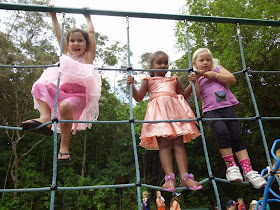
As a society the term ‘risk-taking’ is often considered with negativity. However there is so much to be gained from children engaging in challenge and risk. At Mairtown we know, as do all our whānau, that our children are confident, capable and willing to push their boundaries; to engage in some risky activities which ultimately will provide opportunities for them to learn new skills, try new behaviours and reach their fullest potential. Of course the outdoor environment is the natural place for children to experience risk, and being a nature based Kindergarten (where we spend a morning in the bush with our 10 oldest children) allows for even more exciting experiences to be discovered.

I feel however that overcoming the negatively that is associated with term ‘risk-taking’ is a challenge in itself; but in reality it’s really quite simple. I also know of some who believe that minimal risk taking is the goal for injury prevention, but surely all this does is hinder our children’s development.
Taking risks is simply one of the things children do when they are playing and because a significant amount of playing is about pushing boundaries and extending ourselves, it turns out that most play is risky one way or another (Marc Armitage)

Of course risk can mean different things to different people, and appear differently to different children. I really love the way Clare Warden so simply explains risk as
“The feeling of having a knot in your stomach… the place where you feel out of your comfort zone”. Clearly this will be different for everybody, adults and children alike, but having that knot in your stomach, that feeling of exhilaration, is such a familiar sensation, that I know everyone reading this must know exactly what that feels like, I know I do!

So why do we at Mairtown, and many other teachers and parents value risk-taking? Over recent years much research has been completed on the benefits, and perhaps more importantly the implications of children not partaking in risky play.
What are these? The many benefits of risk-taking through play shows children learn to become responsible and independent for their own actions, they develop coping mechanisms and resilience, it builds self-esteem, problem-solving capabilities and interestingly children develop a respect for danger, for hazards and experimentation – in other words they learn about calculated risk (Nichols, 2000).
The best safety lies in learning how to deal with risk rather than avoiding it.
That’s not to say that we all allow children to engage in experiences that are clearly hazardous. This is where our knowledge of each individual child is so important, knowing about their capabilities, their current resilience levels whilst also accepting that their are benefits to be gained in some small accidents. The scrape of a knee, a bump on the bottom are minor accidents where children will learn greatly through having had the experience – there obviously has to be a balance between risk and safety.


It is really interesting for us at Mairtown when we reflect as teachers, to note that the children we take into the bush each week, despite the potential for more accidents, actually have less. I suspect this is down to the fact that generally children know where their boundaries lie, they know when they’ve gone far enough, and are often more careful because they don’t actually want to get hurt.

There are worrisome potential outcomes of denying our children the opportunity to experience risk. Further research has shown that ‘If children have exciting reasonable risks to undertake [when young] they will be less likely to find and seek out unreasonable risks and hazards when they are older. These young children now, may turn into teenagers and adults who are unable to cope with many everyday situations, have no resilience and may seek out dangerous locations to carry out and experiment with risk-taking (Armitage, Gill). It’s clear that the risk-taking of a 4year old will be quite different to that of a 19 year old!

As I re-read my blog post this week, I almost feel like I’m lecturing a little (!) but this is something, which I’m sure you can tell, I feel passionately about at Mairtown. Here is a little video of our children – see how the risk varies for each child – but I’m sure they are all experiencing the feeling of a ‘knot’ in their stomachs. And as we come to the end of the year, let’s hope our summers are filled with lots of calculated risky and challenging play experiences.
A no risk childhood is risky
(Mac Donald, 2006)
Ma te wa, Christine






































